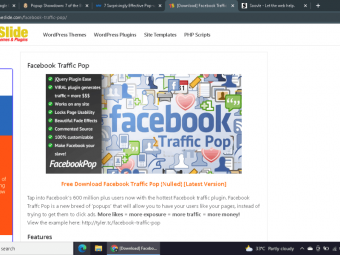Innovationmasterclass Course
Tags: Innovation
The Most Comprehensive Course Available on Developing an Enterprise Innovation Practice
Last updated 2022-01-10 | 4.5
- How to build an innovation practice- How to leverage technology to manage innovation
- How to create rewards and behaviors that will encourage a culture of innovation
What you'll learn
* Requirements
* There are no prerequisites for this courseDescription
- How to build an innovation practice
- How to leverage technology to manage innovation
- How to create rewards and behaviors that will encourage a culture of innovation
- How to determine your organization's propensity for innovation
- How other organizations are leveraging their innovative capabilities
- The components of innovation
- The pitfalls and correct ways to incentivize innovation
- The Seven lessons of Innovation from the world's best innovators
- How to Assess your organization's innovation capability
- Best practices in innovation management
- The role of Leadership in innovation
- How To build innovation as a organizational competency
- How to measure Innovation
- How to create sustainable innovation
- How to increase your ability to create fresh new possibilities and put them to work immediately in your own personal life and your business, profession, or organization
Course content
7 sections • 53 lectures
Innovation in a Hyperconnected World Preview 06:18
In this first segment of the Innovation Master Class you will be introduced to the course and learn about the context that is driving the conversation about the imperative for innovation. We will look at how the behaviors we exhibit in our organizations define a culture which fosters or stifles innovation. We will touch on how connectivity is the fuel which drives innovation and how the recent explosion of connectivity creates a rich environment for innovation to grow in our organizations. Lastly, we will look at how Slingshotting is allowing common, affordable, and simple technologies to be used across all generations, creating a single common platform for innovation and collaboration.
Things to think about before proceeding to the next lecture Preview 00:46
The Challenge of Innovating for the Future Preview 06:36
This segment of the Innovation Master Class is about the relationship between uncertainty and innovation. You will learn that Innovation and invention are not the same, that innovation is about creating value and new behaviors. We will explain the tremendous inability to predict the future because we look at the future through patterns of the past. We will look at how other companies, such as AT&T, predicted the future of technology so well but couldn't predict future behaviors. Lastly we will describe Stockholm Syndrome in your business and how we are often held hostage by:
- Our Processes
- Our Customers
- Our Partners
- Our Culture
Things to think about before proceeding to the next lecture Preview 00:26
Undersanding the Impact and Opportunity of Uncertainty, Behavior, & Datafication Preview 09:20
In this segment we will look at the difficulty in breaking free of past patterns. A notion we will introduce in this segment is Trading on Behavior. Our behaviors are being tracked in a multitude of ways, whether its through our buying behaviors on amazon or in our driving behaviors in our automobiles. The more behavioral info we can track, the more understanding we have of the future, this is called Datafication, and we will look at how it differs from digitization. We will also discuss The Uncertainty Principle, which shows how as uncertainty increases over time the duration of each opportunity decreases. We will distinguish uncertainty from probability and discuss how this increases the need for innovation. We will look at how companies such as Ford, Nike, and Swatch are moving from mass production to mass innovation, and how Customer and User Experience is increasingly important to building an innovative experience around your product or service.
BE SURE TO COMPLETE THE 4 (FOUR) EXERCISES IN THE RESOURCES OF THIS SEGMENT
Things to think about before proceeding to the next lecture Preview 00:25
How well do you understand Innovation?
This quiz will assess how well you understand the fundamentals of innovation discussed in Section One of the course.
Defining the Process of Innovation Preview 08:29
This segment looks at the Process of innovation and how imposing a level of rigor a science is critical to making innovation a process and system that helps to counterbalance uncertainty. We will introduce the market/business model framework as a means of understanding how innovation occurs when both the business and market models change in away that allows them both to synchronize around the value being realized.
BE SURE TO COMPLETE THE EXERCISE IN THE RESOURCES OF THIS SEGMENT
Things to think about before proceeding to the next lecture Preview 00:31
Laws 1&2 of Innovation: Go Where the Fear Is, Be Impervious to Rejection Preview 10:43
This segment looks at the importance of going where your competitors fear to go and developing an attitude that is impervious to rejection as a way to enter new markets while the market ramps up. We will also discuss the value of competitive collaboration in developing new innovations that require broader acceptance in order to deliver enough value ot the market.
Things to think about before proceeding to the next lecture Preview 00:39
Laws 3&4 of Innovation: It's Not Invention, It's Not A Solo Flight Preview 07:05
This segment looks at how invention differs from innovation and also how innovation is increasingly becoming a collaborative process. We use the example of Boston Beer Company (Sam Adams) to illustrate the ability to innovate without inventing something new. We will also look at the trends that illustrate how team-based innovation is increasingly becoming the norm.
Things to think about before proceeding to the next lecture Preview 00:30
Law 5 of Innovation: It's Always A Threat To Yesterday's Success Preview 05:45
This segment looks at how new ideas that come from outside of an industry are often ignored by incumbents because they threaten their existing investment in process, infrastructure, and business models. We will use the examples of businesses such as Uber, Lyft, Zipcar, and airbnb to illustrate how quickly a new business model, enabled by technology, can disrupt and overtake an existing business model.
BE SURE TO COMPLETE THE EXERCISE IN THE RESOURCES OF THIS SEGMENT
Things to think about before proceeding to the next lecture Preview 00:25
The Process and Five Laws of Innovation
This quiz will assess how well you understand the basics of the innovation process and the five laws of innovation.
Building An Innovation Zone: The Kodak Case Study Preview 12:49
This segment introduces the concept of an Innovation Zone and uses the example of Kodak and digital photography to illustrate how the lack of an Innovation Zone can prevent ideas from finding their way to market as the natural inclination of the organization to stay its course with its existing, and often successful, products.
Things to think about before proceeding to the next lecture Preview 00:39
Building An Innovation Zone: The Partners Health Care Case Study (Part1) Preview 10:55
This segment introduces the concept of an Innovation Zone within the case study of Partners Health Care and it's Research and Venture Licensing group (RVL). We will review how the RVL came into being, the context of health care research and how it is driving the need for innovation, and the basic process of the RVL in capturing and evaluating ideas.
Building An Innovation Zone: The Partners Health Care Case Study (Part2) Preview 10:33
This segment looks at the Partners RVL case in greater detail. We will cover the way that the RVL brings simple ideas to market, how it defines a pathway for the idea, budgets for ideas, and creates and "Internal Exit" for people with good ideas.
Things to think about before proceeding to the next lecture Preview 00:38
Introduction to Innovation Zones
This quiz will assess your understanding of the basics behind building an innovation zone and the its specific application to the Kodak and Partners Health Care case studies.
Innovation Leadership Preview 11:28
This segment looks at the importance of having in place the right sort of leadership to foster and promote innovation. We will discuss categories of leaders and also review the qualities of leadership that are considered most valuable for an innovative organization.
BE SURE TO COMPLETE THE EXERCISE IN THE RESOURCES OF THIS SEGMENT
Things to think about before proceeding to the next lecture Preview 00:28
The Role Core Competency and The Importance of Spotting An Innovation Appex Preview 06:02
This segment looks at the importance of having leadership that defines the organization's core competency as a means of setting a compass for innovation that extends beyond products and business models. We will use the concept of an Innovation Apex to illustrate how a strong core competency allows an organization to move quickly when the right set of external factors converge to create an opportunity to deploy a new innovation.
Things to think about before proceeding to the next lecture Preview 00:26
Building a Structure For Innovation and The Innovation 2.0 Framework Preview 06:41
This segment looks at how you can build a portfolio approach to innovation by using the Innovation 2.0 framework. We will review the concept of value creation and innovation plotting various categories of innovation within a matrix with two innovation dimensions, from Incremental to Radical, and Component to Systemic.
BE SURE TO COMPLETE THE EXERCISE IN THE RESOURCES OF THIS SEGMENT
Things to think about before proceeding to the next lecture Preview 00:42
How to Co-create With A Marketplace by Synchronizing the Market and Business Preview 05:46
This segment looks at the concept of co-creation with a marketplace and how Open Innovation is changing the way innovation happens by shifting some of the responsibility for new idea creation outside of the organization. We will use Precor to illustrate the mindset of an Open Innovator and other examples to talk about how Open Innovation is being scaled through idea marketplaces such as Innocentive.
Things to think about before proceeding to the next lecture Preview 00:27
Leading and Organizing Innovation
This quiz assesses your understanding of the role of leadership, structure, an innovation 2.0 portfolio, and open innovation
The 7 Lessons of Innovation 1) Build For The Unknown Preview 09:10
This segment looks at the challenge of innovating in cases where big bets, or "moonshots," need to be made by an organization in order to survive. We will use the example of NASA and the space race of the 1960s to illustrate how extreme leadership commitment is often needed to see an organization through this sort of a period of radical innovation.
Things to think about before proceeding to the next lecture Preview 00:26
The 7 Lessons of Innovation 2) Fail Fast Preview 12:26
This segment looks at the importance of quickly adjusting to a market's movements as it embraces a new innovation. We will use the example of Apple and Sony within the MP3 wars of the late 1990s and early 2000s to illustrate how Apple was able to step in and hijack a marketplace from Sony which Apple had no right to be in when compared to Sony's broad footprint in media.
BE SURE TO COMPLETE THE EXERCISE IN THE RESOURCES OF THIS SEGMENT
Things to think about before proceeding to the next lecture Preview 00:40
The 7 Lessons of Innovation 3) Abandon The Success Of The Past Preview 06:41
This segment looks at the threat posed when organizations latch on so tightly to the past that they are unable to move into the future, in some cases leading to near fatal consequences. We will continue using the example of Sony, and more specifically its attachment to its Betamax video tape ormat as an illustration of how easy it, even for an very innovative organization, is to fall into this trap.
Things to think about before proceeding to the next lecture Preview 00:32
The 7 Lessons of Innovation 4) Separate The Seeds From The Weeds Preview 09:54
This segment looks at the difficulty in separating ideas that might otherwise be considered distractions or disruptors to your current products. We will use the example of OnStar at GM and review its history to better understand the challenges and the ultimate value of putting in place an evaluation process and having comitted leadership that focuses on the value of innovation.
Things to think about before proceeding to the next lecture Preview 00:36
The 7 Lessons of Innovation 5) Focus On Process Over Product Preview 09:20
This segment looks at the critical importance of having in place a process by which innovation can survive even when discoveries or experiments, that would otherwise be considered failures, produce outcomes that are not in keeping with the intended objectives of the organization. We will use 3M and PostIt notes as examples of how this focus on process has palyed out at 3M throughout its history and how it lead to the famous 15% rule that 3M and more contemporary players, such as Google, have put in place.
Things to think about before proceeding to the next lecture Preview 00:31
The 7 Lessons of Innovation 6) Create An Innovation Experience Preview 08:48
This segment looks at how experience (specifically that of a customer or user) offers nearly infinite opportunity for innovation. We will look at how new business models from disruptive players such as Zipcar, Uber, airbnb, Lyft and others have radically altered existing and stale markets by focusing on the customer experience over the incremental enhancement of the product .
Things to think about before proceeding to the next lecture Preview 00:25
The 7 Lessons of Innovation 7) Challenge Conventional Wisdom Preview 08:39
This segment looks at how innovation often comes from outside of an industry due to the difficulty internal players and incumbent have with challenging the fundamentals of why their products or services exist. We look at how iRobot, an outsider to the vacuum cleaner business, was able to challenge the notion that vacuuming must happen manually rather than robotically. iRobot's success will be used to illustrate how even in the face of a strong, and perhaps superior, option to conventional wisdom providers and markets move slowly to adopt innovations that do not fit the patterns of behavior they are accustomed to.
BE SURE TO COMPLETE THE EXERCISE IN THE RESOURCES OF THIS SEGMENT
Things to think about before proceeding to the next lecture Preview 00:31
The Seven Lessons of Innovation
This quiz will assess your understanding of the seven lessons of innovation and the included cases.
Measuring Innovation And Using The Innovation Chain Framework Preview 06:18
This segment covers the basics of measuring innovation over time. We look at the way leading companies measure innovation and discuss the framework of the Innovation Chain as a method of breaking down the major categories across which innovation must be enabled in order to create the most effective path from idea to value. We will also introduce the concept of the Velocity of Innovation which we build on in the next segment.
BE SURE TO COMPLETE THE EXERCISE IN THE RESOURCES OF THIS SEGMENT
Things to think about before proceeding to the next lecture Preview 00:25
Examples Of How To Measure Innovation Preview 10:23
This segment covers the specifics of how the Velocity of Innovation can be measured and compared to competitors or across an internal portfolio. We will look at the actual math behind measuring velocity and apply it to several hypothetical cases, and talk about how you can apply it to your organization.
BE SURE TO COMPLETE THE EXERCISE IN THE RESOURCES OF THIS SEGMENT
Things to think about before proceeding to the next lecture Preview 00:27
Measuring Innovation
This quiz will assess your understanding of how you can measure innovation.








 This course includes:
This course includes:






